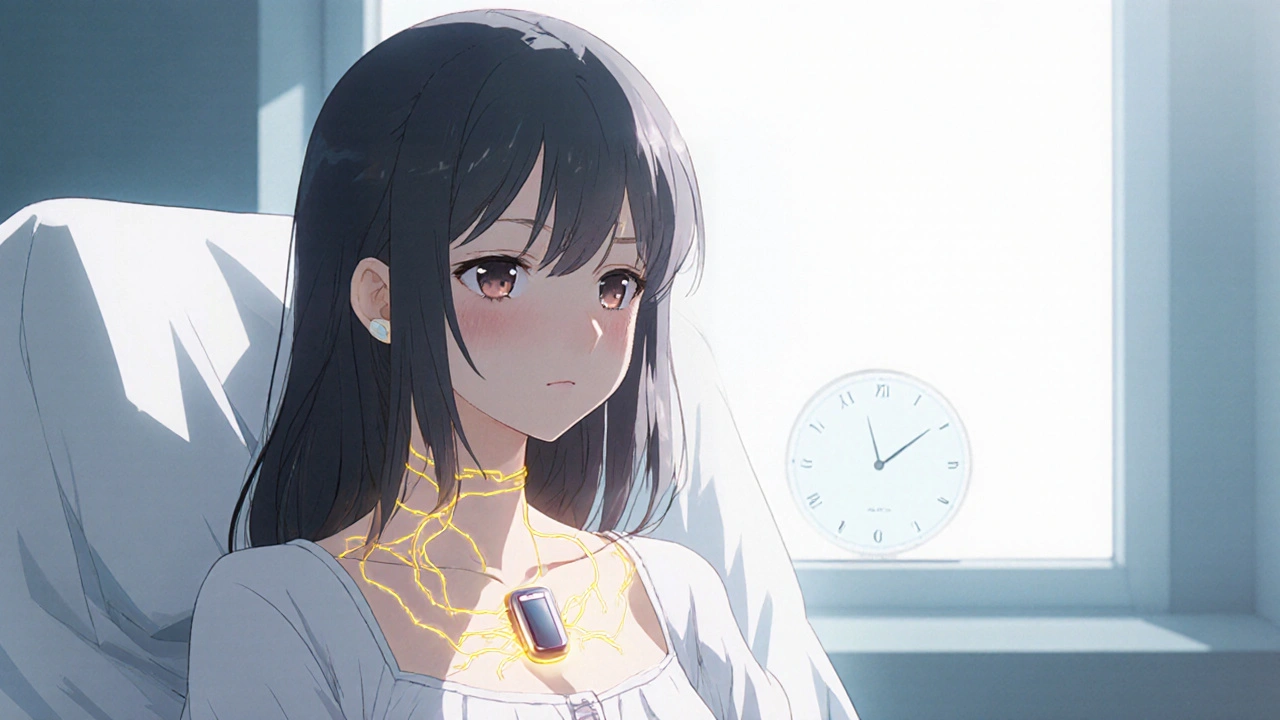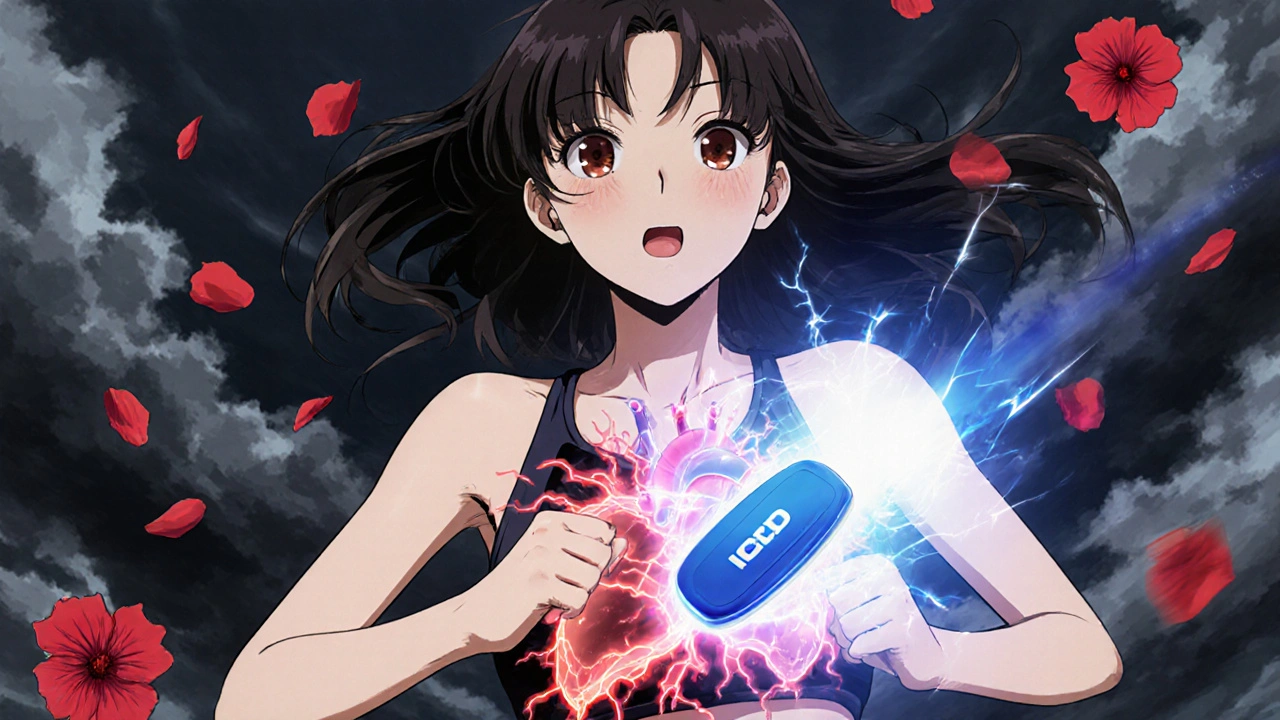
What Exactly Is an Arrhythmia?
Your heart beats because of electrical signals that travel through it in a precise pattern. When those signals get mixed up, your heart might beat too fast, too slow, or irregularly. That’s an arrhythmia. It’s not always dangerous - some people live with mild ones their whole lives without knowing. But others can have serious, even life-threatening rhythms that need immediate attention.
The three most common types you’ll hear about are atrial fibrillation, bradycardia, and tachycardia. Each affects the heart differently, and each needs a different approach to manage.
Atrial Fibrillation: When Your Heart’s Upper Chambers Go Chaotic
Atrial fibrillation, or AFib, is the most common serious heart rhythm problem. Instead of beating in a steady rhythm, the upper chambers of your heart (the atria) quiver or flutter. This means blood doesn’t pump out properly - and that’s where the real danger lies.
When blood pools in the atria, it can form clots. If one breaks loose, it can travel to your brain and cause a stroke. People with AFib have about five times the risk of stroke compared to those with normal heart rhythms. That’s why doctors don’t just treat the fluttering - they treat the risk too.
Symptoms vary. Some people feel their heart racing, pounding, or skipping beats. Others feel tired, short of breath, dizzy, or like they can’t exercise like they used to. But here’s the thing: a lot of people with AFib feel nothing at all. That’s why checking your pulse regularly matters. If it feels irregular - like it’s jumping around instead of beating steadily - get it checked.
Diagnosis usually starts with a simple electrocardiogram (ECG). If the irregular rhythm comes and goes, your doctor might ask you to wear a small monitor for 24 hours or longer. Blood tests, echocardiograms, and chest X-rays help rule out other causes like thyroid issues or heart damage.
Treatment has three goals: control your heart rate, restore a normal rhythm if possible, and prevent clots. Most people start with medications - beta-blockers or calcium channel blockers to slow the heart, and blood thinners like warfarin or apixaban to prevent strokes. If meds don’t help, or if symptoms are severe, doctors may try cardioversion. That’s an electric shock, given under sedation, to reset the heart’s rhythm.
For those who keep having AFib despite meds, cardiac ablation is an option. This procedure uses heat or cold to scar small areas of heart tissue that are causing the faulty signals. A newer method, called pulsed field ablation, uses electrical pulses instead of heat or cold. It’s faster and carries less risk of damaging nearby tissues like the esophagus.
Lifestyle changes are just as important. Losing weight, cutting back on alcohol, quitting smoking, and managing high blood pressure can reduce how often AFib happens - even if you’re on medication.
Bradycardia: When Your Heart Beats Too Slow
Bradycardia means your heart beats slower than 60 times per minute. For athletes or very fit people, that’s normal. Their hearts are strong and efficient - they don’t need to beat fast to pump enough blood.
But for others, a slow heart rate can be a problem. If your heart doesn’t pump enough blood to your brain and body, you might feel dizzy, faint, tired, or short of breath. In severe cases, you could pass out or even go into heart failure.
Causes vary. It can be from aging - the heart’s natural pacemaker weakens over time. It can come from heart disease, like a heart attack that damaged the electrical system. Certain medications, especially beta-blockers or digoxin, can also slow the heart too much. Sometimes, it’s linked to thyroid problems or electrolyte imbalances.
Diagnosis is straightforward. An ECG will show the slow rhythm. If it’s intermittent, a Holter monitor (a portable ECG worn for 24-48 hours) or an event recorder (worn longer, triggered when you feel symptoms) helps catch the pattern.
Not every case needs treatment. If you’re healthy and feel fine with a slow pulse, your doctor might just watch it. But if you have symptoms, the usual fix is a pacemaker. It’s a small device implanted under your skin, usually near the collarbone. It sends electrical impulses to your heart when it detects a rhythm that’s too slow.
Pacemakers are reliable and last 5-15 years depending on usage. Most people go back to normal life quickly after implantation. The big risk? Infection at the implant site or the device malfunctioning - but these are rare.
It’s important to know that some medications that cause bradycardia can be adjusted or swapped out. Always talk to your doctor before stopping anything.

Tachycardia: When Your Heart Races Out of Control
Tachycardia means your heart beats faster than 100 beats per minute at rest. There are many kinds, but the most common ones start in the upper chambers (supraventricular tachycardia) or the lower chambers (ventricular tachycardia).
Supraventricular tachycardia (SVT) often hits younger, healthy people. It can come on suddenly - your heart might race to 150 or 200 beats per minute for minutes or hours. You might feel your chest pounding, get dizzy, or even feel like you’re going to pass out. It’s scary, but usually not life-threatening.
Ventricular tachycardia (VT) is more dangerous. It starts in the heart’s lower chambers and can lead to sudden cardiac arrest if it lasts more than a few seconds. People with prior heart damage - like from a heart attack - are at higher risk.
Triggers include stress, caffeine, alcohol, dehydration, or an overactive thyroid. In some cases, there’s no clear cause.
Diagnosis again starts with an ECG. For episodes that come and go, wearable monitors help. An electrophysiology study - where thin wires are threaded into the heart - can map the exact source of the fast rhythm.
Treatment depends on the type and severity. For SVT, simple tricks like the Valsalva maneuver (holding your breath and bearing down like you’re having a bowel movement) can sometimes stop it. Medications like adenosine can also reset the rhythm quickly.
For recurring SVT or dangerous VT, ablation is often the best long-term solution. It targets the faulty electrical pathway and destroys it with heat or cold. Many people never have another episode after ablation.
If you’re at high risk for sudden cardiac arrest - like someone with a history of heart attack and VT - your doctor might recommend an implantable cardioverter-defibrillator (ICD). It’s like a pacemaker on steroids. If your heart goes into a deadly rhythm, it delivers a shock to reset it automatically.
When to Worry - And When Not To
Not every irregular heartbeat is a crisis. A skipped beat now and then? Usually harmless. A racing heart after coffee or a workout? Normal.
But if you’re having symptoms like chest pain, fainting, extreme fatigue, or shortness of breath that doesn’t go away - don’t wait. Go to the ER or call your doctor right away.
Also, if you’re over 65, have high blood pressure, diabetes, or a history of heart disease, even mild symptoms should be checked. AFib risk goes up sharply with age.
And remember: if you’ve been diagnosed with any of these arrhythmias, follow up regularly. Medications change. Your heart changes. What worked last year might not be enough now.

Lifestyle: Your Hidden Tool Against Arrhythmias
Medications and devices help - but your daily habits matter just as much.
- Limit alcohol. Even one drink a day can trigger AFib in some people.
- Watch your caffeine. Coffee, energy drinks, and chocolate can push your heart rate up. Try cutting back for a week and see if symptoms improve.
- Manage stress. Anxiety and chronic stress raise adrenaline, which can trigger arrhythmias. Walking, breathing exercises, or even talking to a counselor can help.
- Keep your blood pressure under control. High blood pressure strains the heart and makes arrhythmias more likely.
- Exercise regularly. Aim for 30 minutes of moderate activity most days. Don’t overdo it - intense endurance sports can sometimes trigger arrhythmias in susceptible people.
- Don’t smoke. Smoking damages heart tissue and increases the risk of all types of arrhythmias.
What Happens If You Ignore It?
Ignoring an arrhythmia can have serious consequences.
With AFib, the biggest risk is stroke. Many strokes from AFib are silent - people don’t even realize they had one until they start having memory problems or weakness on one side.
With untreated bradycardia, your brain doesn’t get enough oxygen. That can lead to falls, injuries, or even heart failure over time.
And ventricular tachycardia? Left unchecked, it can turn into ventricular fibrillation - a chaotic, deadly rhythm that stops the heart from pumping. Death can happen in minutes.
That’s why early detection and management aren’t optional. They’re essential.
Can arrhythmias go away on their own?
Sometimes, yes - especially if they’re triggered by temporary things like stress, caffeine, or illness. A single episode of SVT might stop on its own with a breathing trick. But if arrhythmias keep coming back, or if they’re linked to heart disease, they won’t disappear without treatment. Waiting too long can make them worse.
Is atrial fibrillation always dangerous?
Not always - but it’s always serious. AFib itself doesn’t usually kill you directly. But the increased risk of stroke makes it one of the most dangerous arrhythmias. Many people live for years with AFib and never have a stroke - if they’re on blood thinners and managing their health. Ignoring it, though, is risky.
Can I still exercise if I have an arrhythmia?
Usually, yes - but it depends on the type and severity. Most people with well-controlled AFib, bradycardia, or SVT can do moderate exercise like walking, swimming, or cycling. Avoid extreme endurance sports if you have a history of ventricular arrhythmias. Always check with your doctor before starting or changing your routine.
Do I need a pacemaker if I have bradycardia?
Only if your slow heart rate is causing symptoms like dizziness, fainting, or fatigue. If you’re fit and feel fine with a pulse of 50 bpm, you likely don’t need one. But if your heart isn’t keeping up with your body’s needs, a pacemaker is safe, effective, and often life-changing.
Are there natural ways to treat arrhythmias?
There’s no proven natural cure, but lifestyle changes can make a big difference. Reducing alcohol, quitting smoking, managing stress, and eating a heart-healthy diet can reduce how often arrhythmias happen. But these don’t replace medical treatment - they support it. Never stop prescribed meds without talking to your doctor.
Next Steps: What to Do Now
If you’ve noticed irregular heartbeats or symptoms like dizziness or fatigue:
- Check your pulse for a full minute. Is it steady or irregular?
- Write down when symptoms happen - after coffee? During stress? At night?
- Make an appointment with your GP. Don’t wait for it to get worse.
- If you’re already diagnosed, keep your follow-up appointments. Don’t skip blood tests or ECGs.
- Start small with lifestyle changes - one at a time. Cut out late-night soda. Take a 10-minute walk after dinner.
Heart rhythm problems don’t always scream for attention. Sometimes, they whisper. Listen closely - your heart will thank you.






There are 12 Comments
Iives Perl
steve stofelano, jr.
Savakrit Singh
Cecily Bogsprocket
Jebari Lewis
Emma louise
sharicka holloway
Alex Hess
Leo Adi
Melania Rubio Moreno
Gaurav Sharma
Jonah Thunderbolt
Write a comment
Your email address will not be published. Required fields are marked *